| |
ENVIS Technical Report: 43, February 2012 |
 |
ECOLOGICAL STATUS OF DANDELI ANSHI TIGER RESERVE |
 |
Energy and Wetlands Research Group, Centre for Ecological Sciences,
Indian Institute of Science, Bangalore – 560012, India.
*Corresponding author: cestvr@ces.iisc.ac.in
|
|
AMPHIBIANS
Amphibians are tetrapod vertebrates first appeared on the earth nearly 360 million years ago. Amphibians are one of the best bioindicators as they respond to the minute disturbances in their habitat or in the environment. Their relatively wide distribution, bimodal life style (aquatic tadpole and terrestrial adults), ectothermic conditions with stable environmental temperature of 20-30°C and moist permeable skin have made them highly sensitive and susceptible to the external changes. Amphibians are pivotal organisms both as prey and predator in many food chains and constitute a vital component of the ecosystem. In ecosystem management, they are the best biological pest controllers.
Amphibians are present in many habitats and microhabitats. They can be found inside the water, muddy and rock crevices, burrowing deep in the soil, or bushes, high canopy trees etc. Amphibians are a plenty during rainy season, as they require water to breed and to lay eggs. Majority of the amphibians are active during night (nocturnal). Amphibians are well known for their croaking noises (vocal calls), which they generally do to attract the partner. One can easily locate and identify the amphibian species based on their calls.
(http://wgbis.ces.iisc.ac.in/biodiversity/sahyadri_enews/newsletter/issue6/index.htm)
General outlook
Fig. 6. Body parts of a Frog
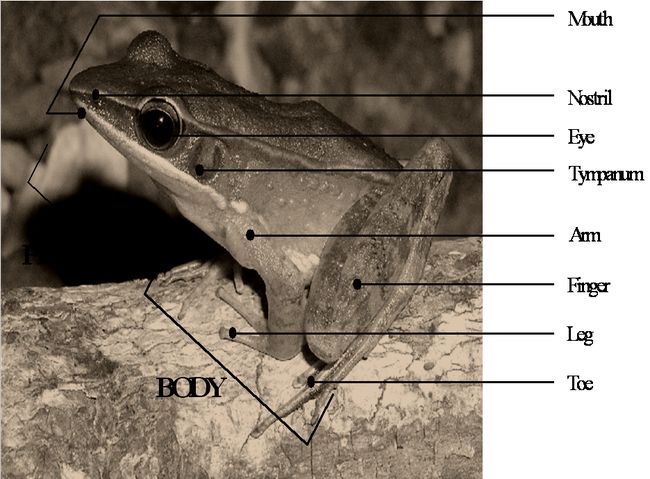
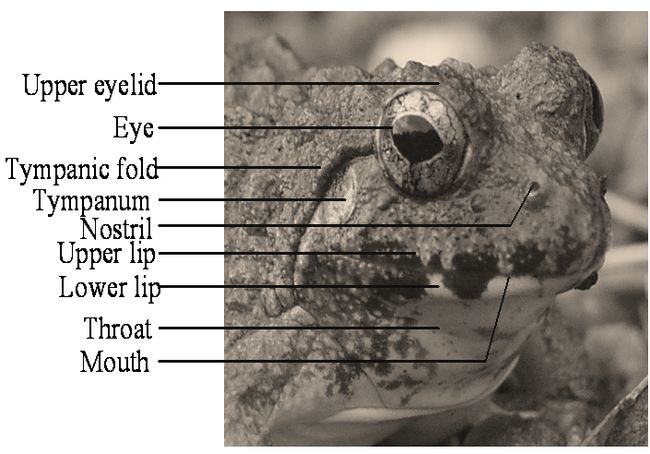
Some common Genera
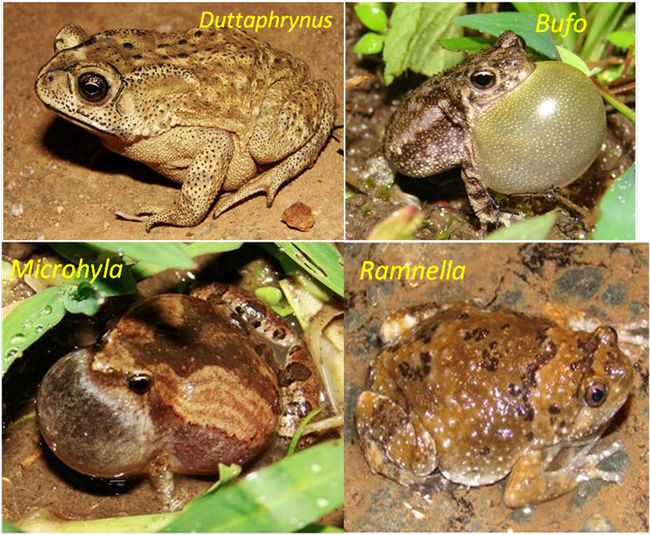
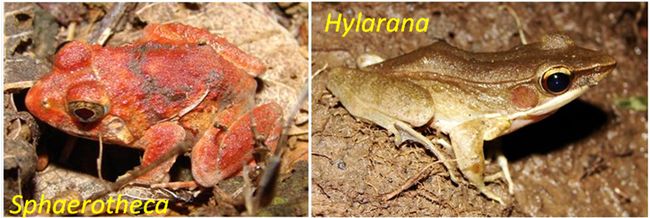
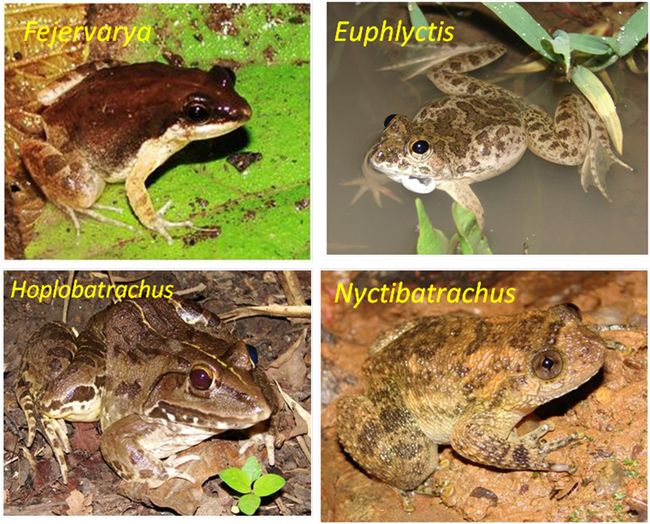
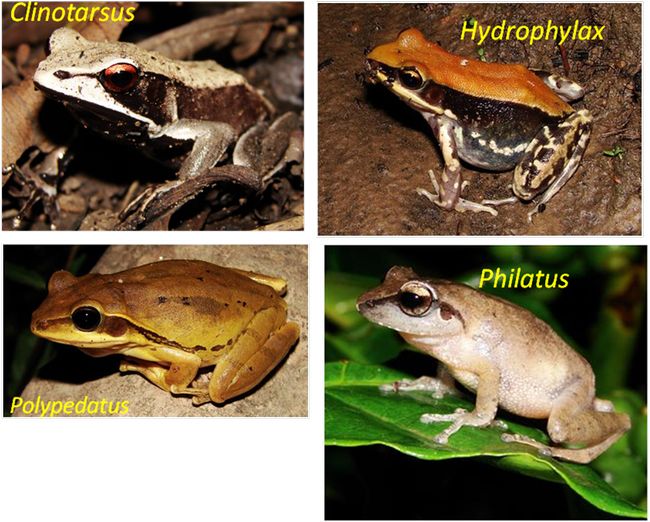
Fig. 7. Some commonly observed genera of frogs in the Western Ghats
The forest official at the forester and guard level were trained in amphibian sampling in streams of Nagazari valley. Table 8 lists the observed anuran species during the past three years of study in the area.
Method
Time constrained sampling: # of man hour search in all-most-all micro habitats. The sampling is done in torch light preferably in late evenings. Usually a search for half an hour by two individuals that is a total of one man hour is sufficient for sampling.
Data Sheet for Amphibian survey
Date:
Time (start):
Time (End):
Latitude: Longitude: Altitude:
Land-use (major): Agriculture/ Pond/ stream/ Evergreen/ Deciduous/ Grassland/
Air temperature: Water temperature:
Relative humidity Canopy cover:
Asphalted road nearby
Table 7: Data table for Amphibian Sampling.
| Species encountered |
Microhabitat/ activity |
# individuals |
| |
|
|
| |
|
|
| |
|
|
| |
|
|
| |
|
|
| |
|
|
| |
|
|
| |
|
|
| |
|
|
| |
|
|
| |
|
|
| |
|
|
| |
|
|
| |
|
|
| |
|
|
| |
|
|
| |
|
|
| |
|
|
| |
|
|
| |
|
|
Table 8: List of amphibians found in DATR during 2006-2009
| Species |
Common Name |
IUCN status |
| Family: Bufonidae |
| Duttaphrynus melanostictus |
Common Indian toad |
Least concerned |
| “Bufo” scaber |
Fergusson’s toad |
Least concerned |
| Family: Microhylidae |
| Microhyla ornata |
Ornate narrow-mouthed frog |
Least concerned |
| Microhyla rubra |
Red narrow-mouthed frog |
Least concerned |
| Kaloula taprobanica |
Indian Painted frog |
Least concerned |
| Family: Dicroglossidae |
| Euphlyctis cyanophlyctis |
Skitter frog |
Least concerned |
| Euphlyctis hexadactylus |
Indian Pond frog |
Least concerned |
| Hoplobatrachus tigerinus |
Indian Bull frog |
Least concerned |
| Fejervarya caperata |
Wrinkled cricket frog |
Data deficient |
| Fejervarya syhadris |
Sahyadri mini-cricket frog |
Data deficient |
| Fejervarya sahyadrensis |
Sahyadri cricket frog |
Data deficient |
| Fejervarya sp. |
|
|
| Family: Ranixalidae |
|
|
| Indirana beddomii |
Beddom’s leaping frog |
Least concern |
| Indirana semipalmata |
Brown leaping frog |
Least concern |
| Family: Ranidae |
|
|
| Clinotarsus curtipes |
Bicoloured Frog |
Near threatened |
| Hylarana temporalis |
Bronzed frog |
Near threatened |
| Hylarana malabarica |
Fungoid frog |
Least concern |
| Family: Rhacophoridae |
|
|
| Polypedates maculates |
Common tree frog |
Least concern |
| Philautus wynaadensis |
Wynaad bush frog |
Endangered |
| Philautus bombayensis |
Bombay bush frog |
Vulnerable |
| Philautus tuberohumerus |
Knobbed hand bush frog |
Data deficient |
| Family: Nyctibatrachidae |
|
|
| Nyctibatrachus petraeus |
Castle rock wrinkled frog |
Least concern |
- IUCN 2008. 2008 IUCN Red List of Threatened Species. <www.iucnredlist.org>. Downloaded on 18 February 2009.
- Note: the list includes the species encountered during monthly surveys carried out earlier and during 13-15th February 2009.
|
|
|
T.V. Ramachandra
Centre for Sustainable Technologies,
Centre for infrastructure, Sustainable Transportation and Urban Planning (CiSTUP),
Energy & Wetlands Research Group, Centre for Ecological Sciences, Indian Institute of Science, Bangalore – 560 012, INDIA.
E-mail : cestvr@ces.iisc.ac.in
Tel: 91-080-22933099/23600985,
Fax: 91-080-23601428/23600085
Web: http://ces.iisc.ac.in/energy
Subash Chandran M.DEnergy & Wetlands Research Group, Centre for Ecological Sciences, Indian Institute of Science, Bangalore – 560 012, INDIA.
E-mail:
mds@ces.iisc.ac.in
Rao G.R
Energy & Wetlands Research Group, Centre for Ecological Sciences, Indian Institute of Science, Bangalore – 560 012, INDIA.
E-mail:
grrao@ces.iisc.ac.in
Amit Yadav
Energy & Wetlands Research Group, Centre for Ecological Sciences, Indian Institute of Science, Bangalore – 560 012, INDIA.
Gururaja KV
Energy & Wetlands Research Group, Centre for Ecological Sciences, Indian Institute of Science, Bangalore – 560 012, INDIA.
E-mail:
gururaj@ces.iisc.ac.in
Karthick B
Energy & Wetlands Research Group, Centre for Ecological Sciences, Indian Institute of Science, Bangalore – 560 012, INDIA.
E-mail:
karthick@ces.iisc.ac.in
Uttam Kumar
Energy & Wetlands Research Group, Centre for Ecological Sciences, Indian Institute of Science, Bangalore – 560 012, INDIA.
E-mail:
uttam@ces.iisc.ac.in
Durga Madhab Mahapatra
Energy & Wetlands Research Group, Centre for Ecological Sciences, Indian Institute of Science, Bangalore – 560 012, INDIA.
E-mail:
durgamadhab@ces.iisc.ac.in
Vishnu D.M
Energy & Wetlands Research Group, Centre for Ecological Sciences, Indian Institute of Science, Bangalore – 560 012, INDIA.
Citation: Ramachandra. T.V, Subash Chandran M.D, Rao GR, Amit Yadav, Gururaja KV, Karthick B, Uttam Kumar, Durga Madhab Mahapatra and Vishnu D.M, 2012. Ecological status of Dandeli Anshi Tiger Reserve., ENVIS Technical Report : 43, Energy & Wetlands Research Group, Centre for Ecological Sciences, Indian Institute of Science, Bangalore 560 012.
* According to IUCN red data list.
* According to IUCN red data list.